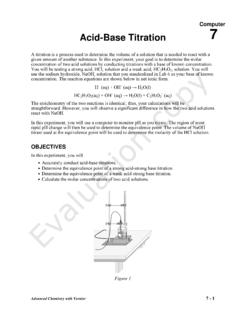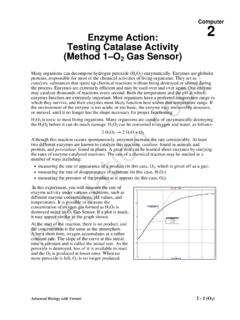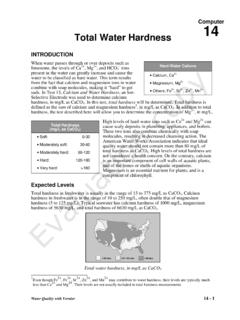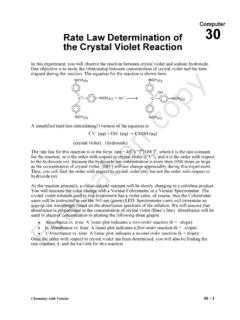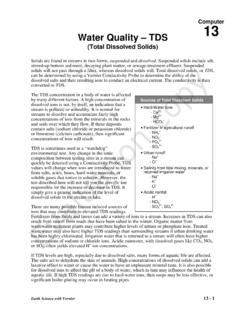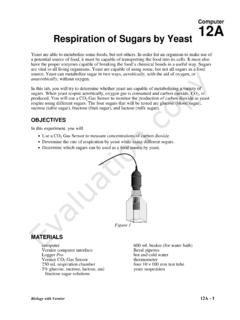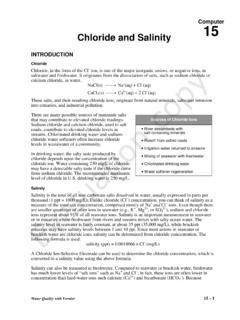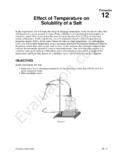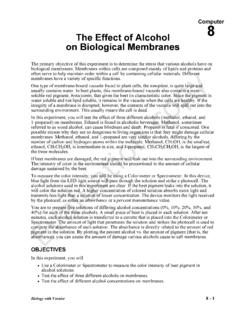Transcription of 25 Titration Diprotic Acid - Vernier Software & Technology
1 Computer 25 Chemistry with Vernier 25 - 1 Titration of a Diprotic acid : Identifying an Unknown A Diprotic acid is an acid that yields two H+ ions per acid molecule. Examples of Diprotic acids are sulfuric acid , H2SO4, and carbonic acid , H2CO3. A Diprotic acid dissociates in water in two stages: (1) H2X(aq) H+(aq) + HX (aq) (2) HX (aq) H+(aq) + X2 (aq) Because of the successive dissociations, Titration curves of Diprotic acids have two equivalence points, as shown in Figure 1.
2 The equations for the acid -base reactions occurring between a Diprotic acid , H2X, and sodium hydroxide base, NaOH, are from the beginning to the first equivalence point: (3) H2X + NaOH NaHX + H2O from the first to the second equivalence point: (4) NaHX + NaOH Na2X + H2O from the beginning of the reaction through the second equivalence point (net reaction): (5) H2X + 2 NaOH Na2X + 2 H2O At the first equivalence point, all H+ ions from the first dissociation have reacted with NaOH base. At the second equivalence point, all H+ ions from both reactions have reacted (twice as many as at the first equivalence point). Therefore, the volume of NaOH added at the second equivalence point is exactly twice that of the first equivalence point (see Equations 3 and 5).
3 The primary purpose of this experiment is to identify an unknown Diprotic acid by finding its molecular weight. A Diprotic acid is titrated with NaOH solution of known concentration. Molecular weight (or molar mass) is found in g/mole of the Diprotic acid . Weighing the original sample of acid will tell you its mass in grams. Moles can be determined from the volume of NaOH titrant needed to reach the first equivalence point. The volume and the concentration of NaOH titrant are used to calculate moles of NaOH. Moles of unknown acid equal moles of NaOH at the first equivalence point (see Equation 3). Once grams and moles of the Diprotic acid are known, molecular weight can be calculated, in g/mole.
4 Molecular weight determination is a common way of identifying an unknown substance in chemistry. You may use either the first or second equivalence point to calculate molecular weight. The first is somewhat easier, because moles of NaOH are equal to moles of H2X (see Equation 3). If the second equivalence point is more clearly defined on the Titration curve, however, simply divide its NaOH volume by 2 to confirm the first equivalence point; or from Equation 5, use the ratio: 1 mole H2X / 2 mol NaOH Volume NaOHpH1st Equivalence Point2nd Equivalence Point Figure 1 Evaluation copyComputer 25 25 - 2 Chemistry with Vernier OBJECTIVE In this experiment, you will identify an unknown Diprotic acid by finding its molecular weight.
5 MATERIALS Materials for both Method 1 (buret) and Method 2 (Drop Counter) computer magnetic stirrer Vernier computer interface stirring bar or Vernier Microstirrer Logger Pro wash bottle Vernier pH Sensor distilled water unknown Diprotic acid , g ring stand ~ M NaOH solution (standardized)
6 1 utility clamp milligram balance 250 mL beaker Materials required only for Method 1 (buret) 50 mL buret 2nd utility clamp 2nd 250 mL beaker Materials required only for Method 2 (Drop Counter) Vernier Drop Counter 100 mL beaker 60 mL reagent reservoir 10 mL graduated cylinder CHOOSING A METHOD Method 1 has the student deliver volumes of NaOH titrant from a buret. After titrant is added, and pH values have stabilized, the student is prompted to enter the buret reading manually and a pH-volume data pair is stored. Method 2 uses a Vernier Drop Counter to take volume readings. NaOH titrant is delivered drop by drop from the reagent reservoir through the Drop Counter slot.
7 After the drop reacts with the reagent in the beaker, the volume of the drop is calculated, and a pH-volume data pair is stored. METHOD 1: Measuring Volume Using a Buret 1. Obtain and wear goggles. 2. Weigh out about g of the unknown Diprotic acid on a piece of weighing paper. Record the mass to the nearest g in your data table. Transfer the unknown acid to a 250 mL beaker and dissolve in 100 mL of distilled water. CAUTION: Handle the solid acid and its solution with care. Acids can harm your eyes, skin, and respiratory tract. 3. Place the beaker on a magnetic stirrer and add a stirring bar. If no magnetic stirrer is available, you need to stir with a stirring rod during the Titration .
8 4. Use a utility clamp to suspend a pH Sensor on a ring stand as shown here. Position the pH Sensor in the Diprotic acid solution and adjust its position toward the outside of the beaker so it will not be struck by the stirring bar. Turn on the magnetic stirrer, and adjust it to a medium stirring rate (with no splashing of solution). Titration of a Diprotic acid : Identifying an Unknown Chemistry with Vernier 25 - 3 5. Obtain approximately 60 mL of ~ M NaOH solution in a 250 mL beaker. Obtain a 50 mL buret and rinse the buret with a few mL of the ~ M NaOH solution. Record the precise concentration of the NaOH solution in your data table.
9 Use a utility clamp to attach the buret to the ring stand. Fill the buret a little above the mL level of the buret. Drain a small amount of NaOH solution into the beaker so it fills the buret tip and leaves the NaOH at the mL level of the buret. Dispose of the waste solution from this step as directed by your teacher. CAUTION: Sodium hydroxide solution is caustic. Avoid spilling it on your skin or clothing. 6. Connect the pH Sensor to the computer interface. Prepare the computer for data collection by opening the file 25a Titration Dip acid from the Chemistry with Vernier folder of Logger Pro. 7. You are now ready to begin the Titration .
10 This process goes faster if one person manipulates and reads the buret while another person operates the computer and enters buret readings. a. Before adding NaOH titrant, click and monitor pH for 5-10 seconds. Once the pH has stabilized, click . In the edit box, type 0 (for 0 drops added), and press ENTER to store the first data pair for this experiment. b. Add enough NaOH to raise the pH by about units. When the pH stabilizes, again click . In the edit box, type the current buret reading, to the nearest mL. Press ENTER. You have now saved the second data pair for the experiment. c. Continue adding NaOH solution in increments that raise the pH about units and enter the buret reading after each addition.
